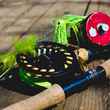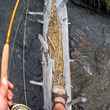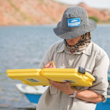Most certainly this was the first fly fishing tactic. At its genesis, fly fishing was a hunter/gatherer tactic, not a sport, although I suspect that its first practitioners found it to be just as much fun as those of us that have ever caught a fish on a fly that he/she tied. It was not practiced with a rod and reel and line and leader; it was very much a "pole and (horse-hair) string" business. There was no shooting line, no double haul, not even any real "casting" per se. It was just a "flop it out there" process, with perhaps the occasional dapping. The currents would have dragged the fly almost instantly, but that could have been an effective method when the fish were taking adult caddis and midges, which the first recorded fly design seems to have suggested.
From the vantage point of long flies -- minnows and leeches, frogs and mice, poppers and gurglers, tubes and hair bugs and so on -- it is with these imitations that the down-and-across swing really shines, because while drag is a nuisance with dead-drifted dries, emergers and other flies of the film, drag can definitely be the long-fly fisher's friend.
As the name clearly indicates, the fly is presented to the fish on a down-and-across cast; typically a 30- to 45-degree angle downstream. The currents are then allowed to swing the fly back across stream until it is hanging straight downstream from the caster. It's a very easy tactic that can yield surprisingly good results. I especially like this tactic in smaller streams that I can easily cast across. I put the fly as tight to the far bank as possible -- right onto the shore if that's feasible -- and allow it to drag across. If there are fish in the near-shore waters along the far bank, they'll hit the fly as it drops into the water and heads off across stream. If there are fish along the angler's bank, they come running as the imitation shoots out of the mid-stream currents and into the quiet shallows.





























